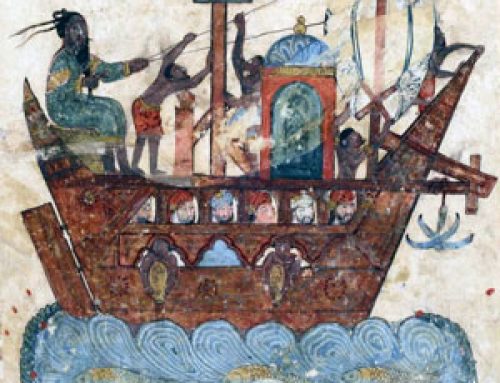
African clothing history: An Egyptian painting of Nubians (from modern Sudan), about 1300 BC
Weaving comes to Africa
By about 2500 BC, some people in Africa started to weave their cloth instead of pounding it, which makes more flexible, comfortable clothing.
What is weaving?
Earlier African clothing
All our Africa articles
People buy clothes instead of making them
The Egyptians learned from their West Asian neighbors how to weave linen, and very quickly professional weavers were doing most of the weaving. Most people bought cloth already made.
What is linen?
West Asian clothing
Ancient Egyptian clothing
People farther south in Sudan bought linen from the Egyptians. Under the Egyptians, and then the Carthaginians, and the Romans, most people in North Africa and East Africa bought their clothes instead of making them themselves.

Egyptian linen from a mummy

A North African man carrying vegetables (Carthage, ca. 300 AD, now in Bardo museum)
Most clothes were wrapped and not sewn
Because cloth was expensive to make, people didn’t want to cut it and waste any. Like people in Europe and Asia at this time, most people wore the cloth wrapped around themselves, rather than cutting it and sewing it to fit them the way we usually do.
Men who were working outside wore just a loincloth (like a bathing suit), wrapped around their waists and tied in various ways.

Black woman wearing raffia skirt
Women, and men who were more dressed up, wore a long piece of cloth wrapped around them in various ways, and sometimes covering their heads. Sometimes they used one long piece for a skirt, and another for a shawl covering their shoulders and chests.
In Egypt, however, people wove plain linen tunics, like long t-shirts, and wore their clothes more shaped to their bodies. Soon people in Meroe, south of Egypt, also wore these tunics. They often had fancy pleating as you can see in the first picture.
Weaving spreads to East Africa and West Africa
The idea of weaving gradually spread from Egypt to other parts of Africa – almost immediately to Meroe, south of Egypt, and across North Africa, and then more gradually down the coast of East Africa, and west to West Africa.
People in West Africa were weaving local grasses or strips of palm leaves into cloth by the 800s AD. By the 1100s AD people were using looms there too. Some people wove linen, others wove other kinds of grass like jute or leaves like raffia.
Knitting and embroidery

Egyptian knitted sock (400s AD, now in Leicester)
About 400 AD, Egyptian textile manufacturers invented knitting with two needles, and they started turning out thousands of knitted socks and stockings. They sold their knitting all over West Asia, and probably also south to Sudan and across Roman North Africa.
History of knitting
Steel sewing needles

Coptic embroidery from Egypt (silk on linen,500-700 AD, now in Metropolitan Museum of Art)
A hundred years later, about 500 AD, Egyptians also got a new way to decorate clothes: the new Chinese invention of steel sewing needles. With these strong, sharp needles Egyptians began to do a lot of embroidery.
Egyptian people embroidered scenes from Roman mosaics, from fresco paintings, and from Iranian carpet patterns. Often they illustrated scenes from the Bible, or from famous Greek or Roman stories. Some people in Egypt decorated their clothes with this embroidery, but traders carried a lot of it on the Silk Road and sold it in Iran, India, and China.
Did you find out what you wanted to know about African clothing history? We have three other articles about it (click the links below).
Learn by doing: weaving
More about medieval African clothing
More about early African clothing
And more about the history of linen
Bibliography and further reading about African clothing:
Traditional African Costumes Paper Dolls, by Yuko Green (1999).
African Girl and Boy Paper Dolls, by Yuko Green (1997).
African Textiles, by John Gillow (2003). Not for kids.



